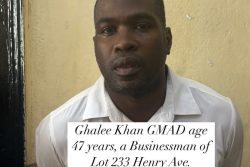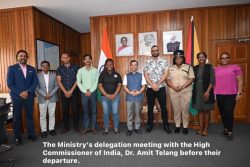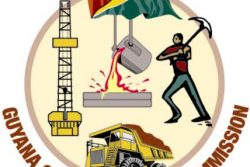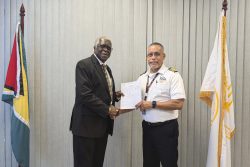Traditionally issues related to historical preservation have never captured the attention of governments in this country. The argument has always been that in a developing nation there are more pressing demands on limited resources and that such matters are at best peripheral to development. They have never been fully persuaded that members of a community are the products of a culture, and that culture is what gives them definition and identity. Food and shelter are about basic survival, not about the validity of individuals as part of a social group, while the shiny new constructions to which our administrations are addicted may have the superficial appeal of modernity, but they lack the soul of a meaningful heritage.
With the advent of the oil economy the argument that the government lacks the wherewithal to invest in culture in its larger sense has now evaporated. And in fairness, in last week’s Budget Minister of Finance Ashni Singh announced a $1.4 billion allocation for Culture and the Arts. This included, among other things, $100 million towards the Endowment Fund for Arts; $100 million to support activities associated with the observance of the International Decade for People of African Descent; $1 million each to thirty artists to encourage creative endeavours; and the setting up of a recording studio. Most important, however, was the assignment of $277 million for the preservation of cultural heritage sites including monuments, museums and historic buildings, among others, which will be upgraded and rehabilitated this year. The current Minister of Culture, however, has never shown much enthusiasm for his portfolio, or even, for that matter, a sure grasp of what all aspects of it entail. While he will certainly have more money for matters directly or indirectly connected to heritage than any of his predecessors had, were he more adventurous and discerning in his thinking he would find it insufficient for his purposes.
While the Budget mentions the upgrading of museums, there is no current museums policy in this country that anyone knows about, so the nature of the ‘upgrading’, therefore, is anything but clear. Does Minister Charles Ramson, Jr have any vision for the sector? Any plans that might bring it into line with modern thinking on museums that is found elsewhere, and not, it might be said, just in the developed world? Do we have any specialists here who have had some training in the field in recent times?
The Walter Roth Museum is the only one which has received some attention on and off, and it is the perfect example of what our politicians think about museums. First Dr Cheddi Jagan attempted to take the building over when he initially came to office so it could house his security details, and then former President David Granger wanted to move its contents out to the National Museum so he could accommodate his staff there. President Jagan was only dissuaded from pursuing his plan when he discovered that Unesco had invested in its documentation centre, while Mr Granger ran into a storm of criticism which caused him as well to reverse his decision.
As for the National Museum that has been in decline for decades, its collection subject to attrition and its displays sometimes idiosyncratic as well as dated. Yet here we are in the 21st century with the government talking breezily about tourism, yet doing none of the things which are necessary if it wants a viable tourist industry – never mind providing a source of information for Guyana’s own population, especially its children. And nothing has been said recently about the creation of new museums either. Local authorities, for example, could be encouraged to create their own little museums or information centres about their areas for which some limited funding could be made available.
But the biggest deficiency at a national level is the absence of a plantation museum of some kind, which would have to be built up from scratch. There has been talk and promises of a sugar museum in the past, but one presumes that GuySuCo is in such dire straits these have fallen by the wayside. Barbados has its plantation houses and the like which tourists visit and which pay for themselves, but Guyana, in the 19th century the largest and most modern sugar producer in the anglophone Caribbean which lent its name to Demerara sugar, has nothing. Yet sugar is the crop which unites all the races in this country, even at a more tangential level the Indigenous inhabitants as well, some of whom were enslaved in earlier times.
A sugar museum would be a massive project which would have to be established in all three counties and include the industrial aspects of sugar processing, ideally with a recreated plantation. In addition, in areas like Berbice, which in the 18th century produced various crops of which sugar was only one (its chocolate was considered high quality in Amsterdam) there would need to be something reflecting the regimes and organisation that those required. Coffy, for example, worked on a cotton estate. And then in Essequibo perhaps, there could be something dedicated to the production of annatto, which in the 17th century was that colony’s main export after sugar and was produced exclusively by the Indigenous people. It was used to colour Dutch cheeses.
The sum of $277 million would be of no use in terms of creating new museums, particularly on the scale of a sugar museum which could only be built up in stages. But before any Minister of Culture could lobby the Minister of Finance for funding at any level, he would have to have a project to present. He needs, therefore, to contact a variety of museum experts as well as knowledgeable people locally to produce the blueprint for a project of this size.
And then there is the matter of preservation which goes well beyond the monuments and historic buildings listed in the Budget. We have been particularly cavalier in Guyana not just about large built structures of one kind or another, but also smaller artefacts. Last year Ms Louisa Daggers told this newspaper in relation to the Indigenous past, that very little was known about the Mazaruni area where gold is mined. Miners and others, she said, find artefacts and then sell them directly to people who establish themselves as collectors. One is reminded of the huge trade in bottles and other Dutch items such Delftware sold to traders who came into the rivers a few decades ago. While the bottles were so numerous they could have been exported under some kind of regulated trade arrangements, the museum never bothered to ensure they had a full collection of all the various types from the different periods.
As it was the diggers disturbed sites, destroyed graves and made historical archaeological work impossible. In the case of the Mazaruni, however, we are talking about prehistory, not a post-Columbian past. Clearly the Ministry has nothing in place to address this particular problem and prevent the destruction of heritage sites. It might be mentioned that in the UK, whenever a company excavating to build some kind of new structure encounters anything which appears ancient, work has to cease and the archaeologists and/or historians are called in. In more recent times that is how most of the new Roman discoveries have been made, although sometimes the findings are more recent than that.
In the case of miners and Guyana the problem for obvious reasons would be a lot more complex; in a general sense we lack a sense of history and how we relate to our past. Ms Daggers also recounted how she sent proposals about a 95,000 hectare site in Berbice, comprising a huge complex of prehistoric mounds which she wanted to protect. She had learnt that lands here were being given out for agriculture and other developments, and she tried to persuade the Ministry there was a need for a cultural and archaeological policy because there was nothing that governed how such sites were managed. Inspired by this little windfall from the Budget, will Minister Ramson now turn his attention to the matter and detail knowledgeable people to draft something for him?
There was also the case, said Ms Daggers, of the middens in Regions One and Two. She described the shell mounds as a wonderful archive of prehistoric information, but since the authorities did not place a great deal of emphasis on conservation, some people just filled their yards with the shell middens. Citing the example of a huge one in the Barama River, she said it had been almost completely mined out.
A failure to understand what needs to be done is not just a consequence of ministerial short-sightedness. Ministers are advised by their public servants, and clearly these lack a sense of what is required and where the priorities lie. Ms Daggers had a revealing little story to tell about the Walter Roth Museum where Ms Jennifer Wishart and Mr Gerard Pereira had spent considerable time trying to get the collections in order, and where she had worked at weekends. They asked for a freezer to preserve some of the artefacts which could become infested with fungi and termites, but two years on they still could not get the freezer. This was despite the fact that the Ministry, she said, was “refurbishing other parts of the museum with fancy furniture and we couldn’t get a freezer to care the very thing that was going to keep the museum in existence. We went back and forth with the Ministry on collections management till I just couldn’t do it any more.”
The moral of the story is that how to go about preserving the heritage should not be left to bureaucrats. The Minister will need all kinds of help from outside his Ministry on the different classes of cultural heritage sites, only two of which have been mentioned here, and the framing of a comprehensive cultural policy which encompasses all of them. The $277 million in this year’s Budget should serve as a stimulus, but it is only a start in terms of what needs to be done.







